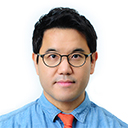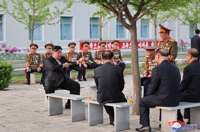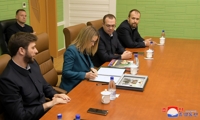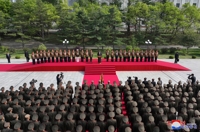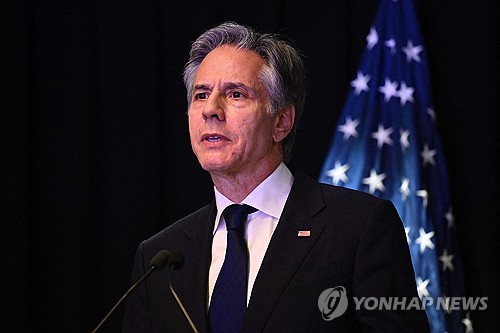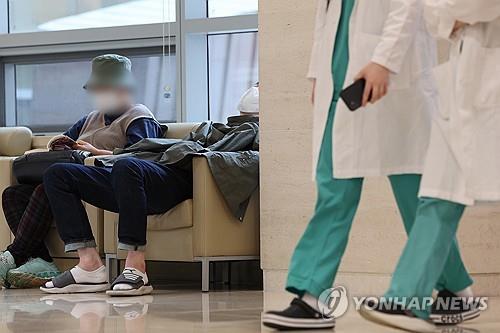Political art juxtaposed with postmodernism in 'Art and Words' exhibit
By Chang Dong-woo
SEOUL, July 17 -- Should art stick its nose into politics or remain oblivious to it?
That perpetual debate surrounding the role or art -- whether it should weigh in on or neglect reality -- raged on in South Korea's art scene during the age of military dictatorship of the 1970s and 80s. Out of the conversation emerged the political and populist art movement called "minjung art," largely in response to the Gwangju Massacre ordered by then-President Chung Doo-hwan in May 1980.
Unbound to a genre or a subset of artists, grassroots works depicting topics of nature, labor, anti-imperialism and anti-authoritarianism were produced en masse to enlighten the public against the political atrocities of the times, often at the risk of political persecution and censorship.
At the forefront of the movement was an art collective named Reality and Utterance, formed of painters, sculptors and installation artists who shared the common question of whether it was adequate for art to turn a blind eye to reality in pursuit of apolitical aesthetics and abstract beauty.

A poster image for the "Art and Words 2020" exhibition at Hakgojae gallery in Seoul, provided by Hakgojae (PHOTO NOT FOR SALE) (Yonhap)
But as the country slowly moved towards democratization, Reality and Utterance was dissolved in 1990, with members pursuing their own individual artistic visions.
The "Art and Words 2020" exhibition under way at the Hakgojae gallery in central Seoul brings together key members of Reality and Utterance to examine their artistic transformations -- by juxtaposing some of their most politically subversive and provocative works with more recent works with abstract flare.
The title of the exhibit is a throwback to the name of a newsletter Reality and Utterance produced for an exhibition held in 1982, which included 11 essays that delved into members' critical reflections on the times.
Hakgojae has brought together 106 past and recent works from 16 former members curated to highlight the career and worldview transformations of the participating artists.
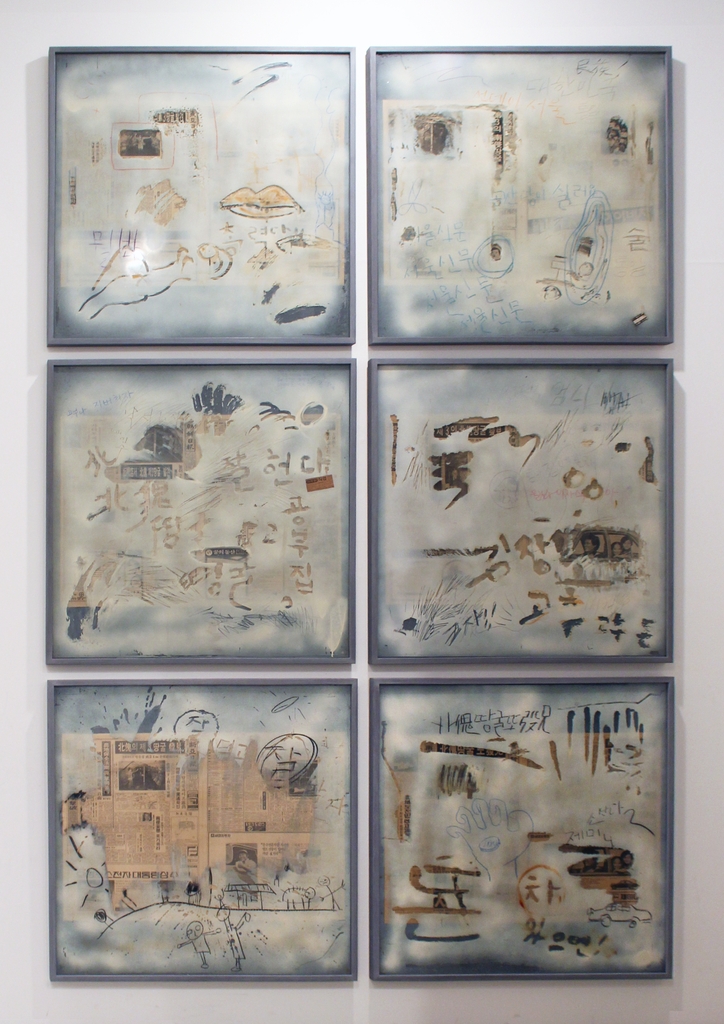
This image provided by the Hakgojae gallery in Seoul shows Im Ok-sang's "Newspaper-Underground Tunnel" series (1978) on display at the "Art and Words 2020" exhibition at the gallery. (PHOTO NOT FOR SALE) (Yonhap)
Lim Ok-sang's 1978 series piece "Newspaper-Underground Tunnel" highlights the people's will in searching for the truth against media censorship and anti-communist propaganda by the government.
Lim encased a collage of 1978 newspapers, with articles on the discovery of secret North Korean underground tunnels to the South, in transparent glass casing, with the front of the case covered with a frosty layer of paint. Parts of the paint are smudged, revealing parts of the text, while some have scribble over them.
"Through the smudge traces, I tried to express the fight for the people's right to know," explained Lim in his artist's notes for the exhibition.
Displayed next to the newspaper piece are Lim's more abstract 2018 works "Earth A4" and "Earth A5," in which black ink is painted over giant 200 centimeter by 350 centimeter canvases covered with mud through the artist's improvised natural body movements.
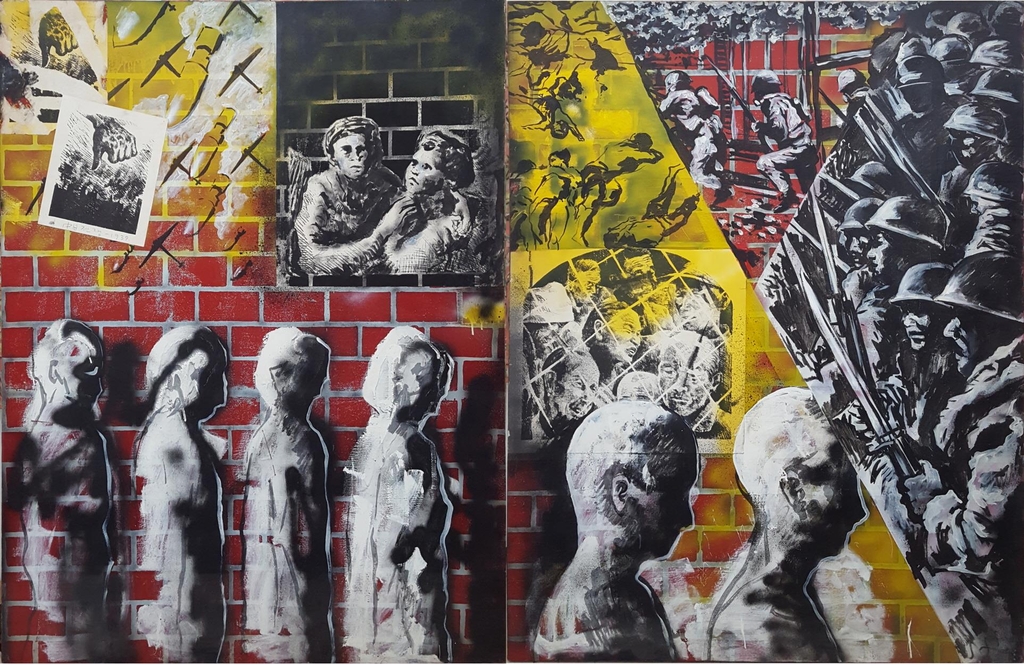
This image provided by the Hakgojae gallery in Seoul shows Min Joung-ki's "1939" (1983) on display at the "Art and Words 2020" exhibition at the gallery. (PHOTO NOT FOR SALE) (Yonhap)
Min Joung-ki presents two pieces, one from 1983 and another from 2020, that share the same title of "1939." Min expresses the harrowing experience of the second Sino-Japanese War of 1937-1945 in the 1983 acrylic painting. The 2020 version of "1939" is an oil painting of a large peak at Mount Inwang in Seoul in which a text praising the Japanese emperor was previously engraved, presumably in 1939.
Also on display is Son Jang-sup's "Looking Through History - Gwanghwamun," a 1981 oil painting largely considered one of the defining masterpieces of 1980s minjung art. One of Son's naturalism paintings, 2012's "Ulleungdo Juniper Tree," is displayed alongside "Gwanghwamun."
Prominent found object sculptures were also brought together. Shin Kyung-ho's 1992 sculpture "Molotov Cocktail - Against the Dictator" is a made of parts that Shin picked up from riot scenes during the late 1980s, such as an unused Molotov cocktail bottle and iron pipes used as protective arms by student protestors against riot police.
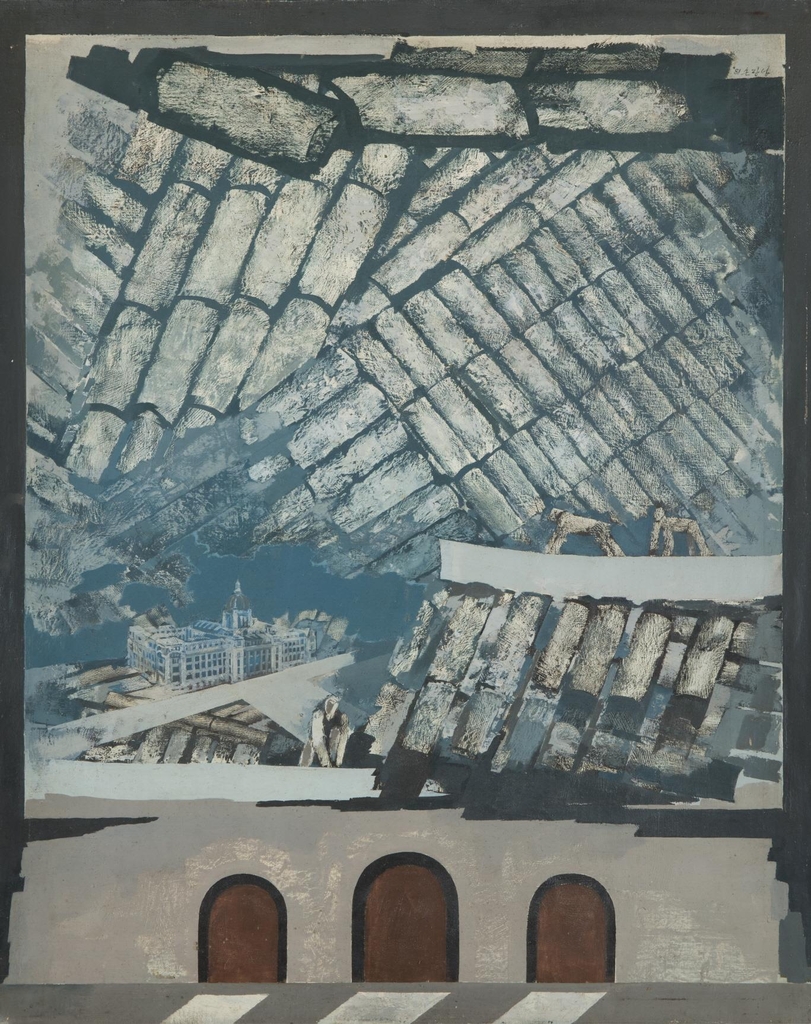
This image provided by the Hakgojae gallery in Seoul shows Son Jang-sup's "Looking Through History - Gwanghwamun" (1981) on display at the "Art and Words 2020" exhibition at the gallery. (PHOTO NOT FOR SALE) (Yonhap)
Alongside the exhibition is a special project room where visitors can randomly run into artists featured in the exhibition and participate in various experimental public art projects.
"It's been 40 years since Reality and Utterance was founded. These artists spoke out on issues of society and politics. But the times have changed and so have their worldviews," Hakgojae exhibition manager Park Miran said.
"Art and Words 2020" runs until July 31 at Hakgojae gallery.
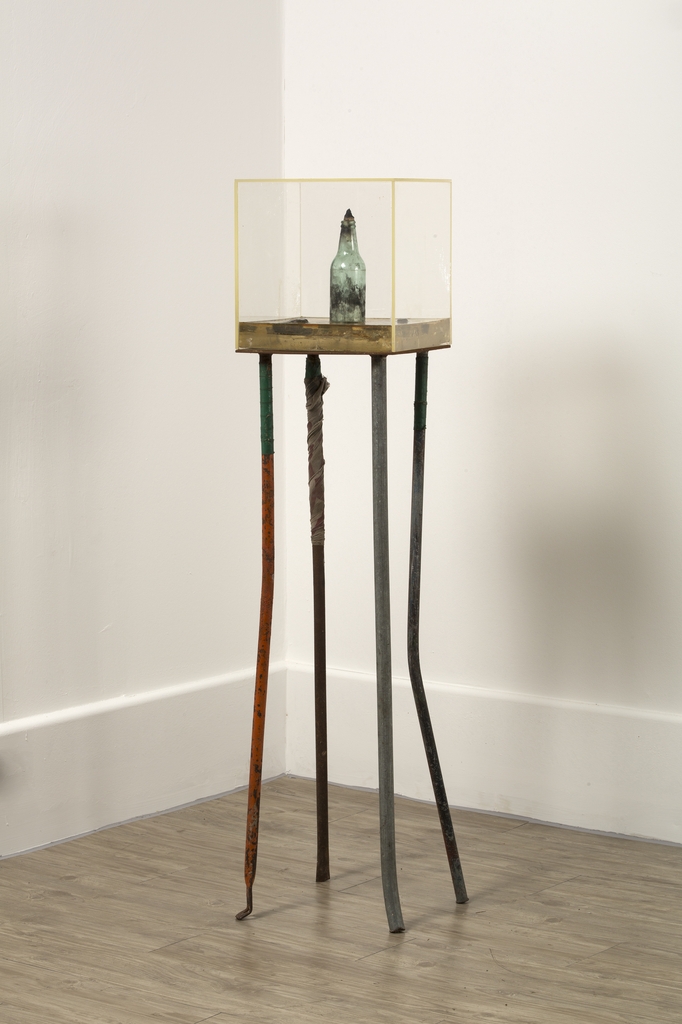
This image provided by the Hakgojae gallery in Seoul shows Shin Kyung-ho's found object sculpture "Molotov Cocktail - Against the Dictator" (1992) on display at the "Art and Words 2020" exhibition at the gallery. (PHOTO NOT FOR SALE) (Yonhap)
odissy@yna.co.kr
(END)
-
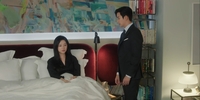 'Queen of Tears' weaves rich tapestry of Korean contemporary art
'Queen of Tears' weaves rich tapestry of Korean contemporary art -
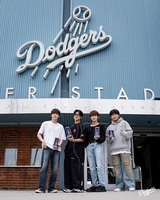 Ateez member Yunho throws first pitch at MLB match between Dodgers, Mets
Ateez member Yunho throws first pitch at MLB match between Dodgers, Mets -
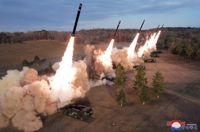 N. Korea says Kim guided simulated nuclear counterattack drills for 1st time
N. Korea says Kim guided simulated nuclear counterattack drills for 1st time -
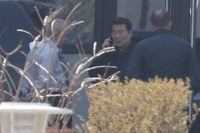 N. Korea calls envisioned U.S. aid to Ukraine 'hallucinogen'
N. Korea calls envisioned U.S. aid to Ukraine 'hallucinogen' -
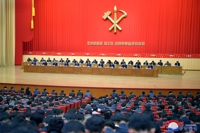 N. Korea calls on party propaganda officials to work harder
N. Korea calls on party propaganda officials to work harder
-
 'Queen of Tears' weaves rich tapestry of Korean contemporary art
'Queen of Tears' weaves rich tapestry of Korean contemporary art -
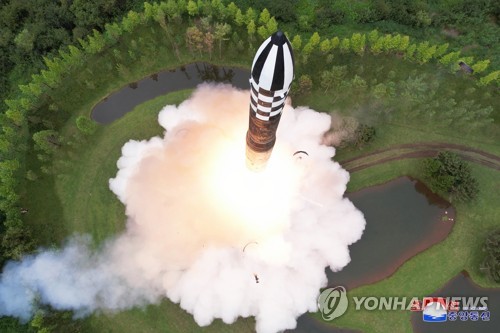 Experts see possibility of N.K. conducting nuclear test before U.S. presidential vote
Experts see possibility of N.K. conducting nuclear test before U.S. presidential vote -
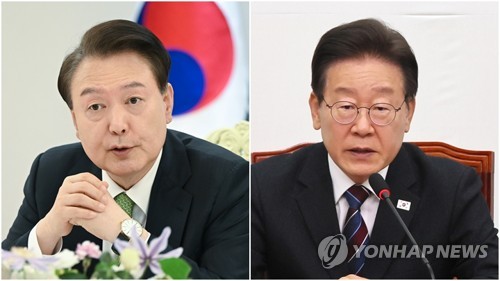 Details of meeting between Yoon, opposition leader undecided: presidential office
Details of meeting between Yoon, opposition leader undecided: presidential office -
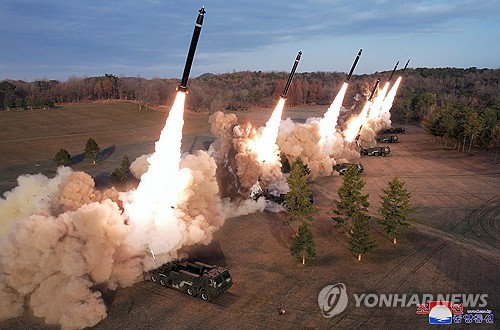 N. Korea says Kim guided simulated nuclear counterattack drills for 1st time
N. Korea says Kim guided simulated nuclear counterattack drills for 1st time -
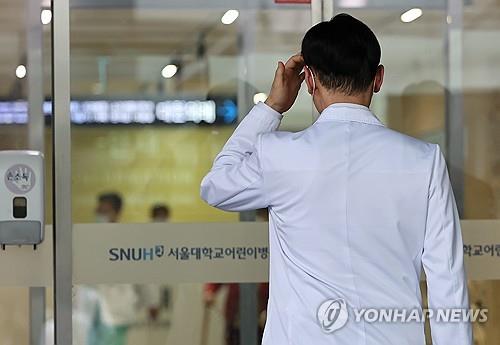 Looming weekly closure of major hospitals feared to worsen medical service crisis
Looming weekly closure of major hospitals feared to worsen medical service crisis
-
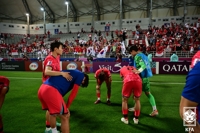 S. Korea eliminated in Olympic football qualifiers as poor defense, undisciplined play prove costly
S. Korea eliminated in Olympic football qualifiers as poor defense, undisciplined play prove costly -
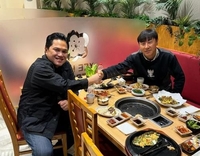 Indonesia coach left with mixed feelings after eliminating native S. Korea in Olympic football qualifiers
Indonesia coach left with mixed feelings after eliminating native S. Korea in Olympic football qualifiers -
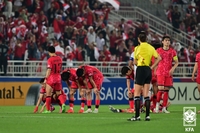 (LEAD) 10-man S. Korea lose to Indonesia to miss out on Paris Olympic football qualification
(LEAD) 10-man S. Korea lose to Indonesia to miss out on Paris Olympic football qualification -
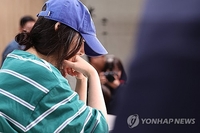 ADOR CEO calls conflict with Hybe 'worst experience of my life'
ADOR CEO calls conflict with Hybe 'worst experience of my life' -
 S. Korea to acquire SM-3 shipborne missiles by 2030
S. Korea to acquire SM-3 shipborne missiles by 2030
